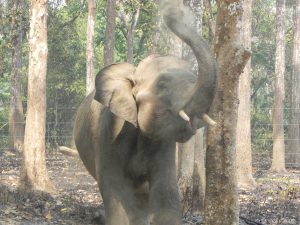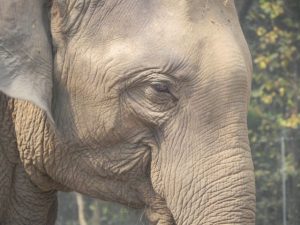March 29
The first two corrals at Kasara hattisar are finally ready.
The air is charged with anticipation.
Rescuing an elephant to sanctuary or releasing them from chains brings the same mix of emotions — anticipation, apprehension and excitement.
Each elephant is a unique individual with a distinct personality. Life’s experiences mold their behavior, shaping them as they mature. Each of them responds differently to different situations.

When I first arrived at the Kasara hattisar, I noticed that young Himal Gaj was resistant to his mahouts. He appeared fearful. An old scar at the base of his trunk indicated a past confrontation.
Watching the mahouts struggle through the morning routine, preparing Himal Gaj for duty, was disconcerting. I wondered how he and the mahouts would respond to going chain-free.
The mahouts were also concerned. They feared for their safety.
As a result, it was decided that Himal Gaj would be released from his tether but would wear loose hobbles until the mahouts felt safe around him.
It was disappointing that Himal Gaj would not immediately be completely free, but the compromise was the first step to his future freedom. If the mahouts fear for their safety, Himal Gaj would be destined for a life in chains.
With time and Compassionate Elephant Care training I hoped Himal Gaj would settle down and become more responsive.
The chains come off
The elephants usually return from their anti-poaching patrol duties around 4pm. Chief Conservation Officer Kamal Kunwar postponed a scheduled meeting so he could be present for this auspicious occasion.
Just before 4pm, the hattisar suba arrived. He’d been out of office for a couple of weeks. He and Kamal discussed the plan in Nepali. I would soon see that following their brief conversation plans would change dramatically.
The elephants arrived back from the forest. To my surprise and contrary to the plan, Himal Gaj was walked directly into his new chain-free corral. He was not put on loose hobbles. Calmly and confidently, his mahout gave the command to bite (stretch out on his sternum). Without hesitation or fear, Himal Gaj calmly responded.
I realized that the mahout I’d seen with Himal Gaj the past week was now assisting, rather than riding.
In that moment things became perfectly clear. The mahout to whom Himal Gaj was resistant to this past week was the junior mahout. And now that his main mahout was back from vacation, everything was fine.
Himal Gaj waited patiently as his gear was removed. Then he rose and immediately began dusting, as his friend and senior mahout left the corral.
What a difference a good relationship makes.
Kamal Kunwar’s turn

I did not have time to dwell on the glory of Himal Gaj’s transformation because Tamor Kali was about to enter her chain-free corral for the first time.
Kamal Kunwar was sincerely excited, filming her first chain-free steps like a proud father.
After seeing how well Himal Gaj responded to his mahout, everyone was engaged and relaxed. They gestured at both young elephants free-of-chains with huge smiles on their faces.
Now was the time to stand back and savor the moment. The instant that life changed for two young elephants and their family of mahouts.
The three other elephants stood chained under their shelter watching the scene.
I whispered, “You’re next ladies.”
It will be close to a week before the other corrals are completed. Without a doubt, Khosi Kali, Laxmi Kali and Prayna Kali, who have all been prisoners to chains for decades, will transition seamlessly.
Imagine the joy when they are all chain-free. Heart bursting JOY!
